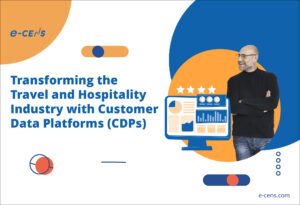This blog is based on our podcast episode named “The Great 3rd-Party Cookie Apocalypse Isn’t Happening!”
It was initially believed that cookies were being deprecated, with Google and Apple hinting at this move since 2018-2019.
However, it turns out that Google has no immediate plans to deprecate third-party cookies.
Instead, they will provide a new Chrome experience, similar to Apple’s approach, and continue to emphasize the use of a privacy sandbox.
This delay in cookie deprecation has left many advertisers unsure of how to proceed, especially given the industry’s constant changes and challenges.
Google’s Evolving Approach to Cookies
Google has been investing in making its products, such as pixels, work in a first-party context to reduce reliance on third-party cookies.
They are also providing tools like the privacy sandbox to balance privacy with ad functionality.
While this may be a convenient excuse for advertisers who haven’t prepared for cookie deprecation, it also highlights the disruption and uncertainty in the advertising ecosystem.
Google’s separate teams for Chrome and ad networks operate with limited internal collaboration, which can create challenges for advertisers. The lack of a clear roadmap and sudden changes can make it difficult for businesses to plan and adapt, especially when revenue is at stake.
The Importance of First-Party Data
Despite the misconceptions and delays, the principles of owning first-party data remain important.
As cookie deprecation or challenges persist, advertisers are encouraged to focus on building direct relationships with customers and engaging with their audiences in new ways.
This shift towards first-party data emphasizes the need for businesses to control their data and understand their customers to market effectively.
Embracing Data Control and Privacy
With the ever-changing landscape of cookie deprecation and evolving privacy regulations, the importance of data control and privacy cannot be overstated.
While the initial plans to deprecate cookies have been delayed, this situation highlights the uncertainty and disruption in the advertising ecosystem.
As Sean Bucher points out, this delay doesn’t mean that advertisers should become complacent. Instead, it underscores the importance of taking control of your data and building direct relationships with customers.
By focusing on first-party data ownership, advertisers can make informed decisions and create effective marketing strategies. For instance, understanding your target audience and their online behavior enables you to tailor your message and reach them in the right context.
This shift also emphasizes the need for compliance with privacy regulations and consent requirements. As Patrick mentions, many advertisers are already missing 30 to 40% of their data due to consent compliance, and this will only become more critical with the ongoing privacy changes.
Strategies for Effective Data Management
To navigate the evolving landscape, advertisers should focus on effective data management strategies.
This includes cleaning and organizing data, as well as creating data ecosystems that allow for efficient data stitching and insights generation.
By investing in data management platforms and analytics tools, advertisers can gain a deeper understanding of their customers and make data-driven decisions.
Additionally, exploring alternative channels such as email, SMS, and push notifications can help engage existing customers and acquire new ones.
Navigating Privacy Regulations and Compliance
As privacy regulations continue to evolve, ensuring compliance and maintaining transparency with customers are crucial.
Advertisers should stay updated with regulatory changes and consent requirements in their respective jurisdictions.
By embracing a privacy-first approach, advertisers can build trust with their customers and future-proof their data practices. This may involve providing clear privacy policies, obtaining consent, and offering opt-out choices to users.
The Limitations of Third-Party Data
As Patrick points out, the data supply chain in programmatic advertising is often inaccurate and unreliable.
His example of Ariel highlights how an individual can be placed in multiple mutually exclusive audience segments, making it challenging for advertisers to reach their intended audience effectively.
This issue is further exacerbated by the lack of diligence from both inventory providers and marketers. As a result, advertisers may end up buying into absolute garbage when targeting specific audiences.
Research by John Bradshaw, founder of Brand Traction, supports this claim. His studies indicate that third-party and second-party audience data are the least effective forms of targeting. Instead, good-quality contextual targeting and first-party data are shown to be more successful.
The Power of Contextual Targeted Advertising
Contextual targeted advertising involves reaching potential customers through the content they consume rather than targeting them individually.
For example, advertising IT products on websites that IT decision-makers frequent is more effective than targeting specific individuals.
This strategy also eliminates the need for first-party data, as advertisers can rely on understanding their ideal customer profile and tailoring their message to the context.
Netflix has successfully demonstrated this approach, as observed by Sean Bucher.
By targeting viewers of the Olympics-themed show “Sprint” with an advert for Simone Biles’ campaign with Athleta, Netflix effectively combined contextual targeting with a compelling message.
This strategy can be particularly useful for generating incremental revenue and reaching new customers.
Enhancing Creative Quality for Better Engagement
While reaching the right audience is crucial, Patrick emphasizes that the quality of creative content is equally important.
Advertisers should focus on crafting compelling messages that align with the context and interests of their target audience.
This combination of contextual targeting and engaging creative content can significantly enhance the effectiveness of advertising campaigns.
Take Action: Steps to Adapt to the Changing Digital Environment
As we’ve explored, the digital landscape is constantly evolving, with cookie deprecation, privacy regulations, and shifts in consumer behavior all presenting challenges and opportunities for advertisers.
So, what steps can you take to adapt and thrive in this environment? Here’s a breakdown:
Assess Your Current Data Practices
Start by evaluating your current data practices and identifying areas where you can improve. Take a critical look at your data management strategies, including data collection, storage, and analysis.
Are there gaps or inefficiencies that need to be addressed? By conducting a thorough assessment, you can identify the strengths and weaknesses of your current approach and lay the foundation for improvement.
Invest in First-Party Data Solutions
As highlighted earlier, first-party data ownership is crucial in the evolving digital landscape. Invest in solutions that help you collect, organize, and analyze first-party data effectively.
This could include implementing customer relationship management (CRM) systems or exploring data management platforms (DMPs).
By owning and controlling your data, you can make more informed decisions and create targeted marketing strategies.
For example, let’s say you’re a retailer. By analyzing first-party data, you might discover that a significant portion of your customers falls into a specific demographic or has particular interests. This insight can inform your marketing campaigns, allowing you to create more relevant and engaging content.
Experiment with Contextual Advertising Techniques
As discussed, contextual targeted advertising can be a powerful tool, especially when combined with compelling creative content.
Experiment with this approach by identifying the right contexts and channels to reach your target audience. Consider the example of advertising IT products on websites frequently visited by IT decision-makers.
By understanding your ideal customer profile and tailoring your message to the context, you can effectively reach your intended audience.
Additionally, don’t be afraid to think outside the box. As Sean Bucher mentioned, it’s important to make informed decisions for your creative teams and branch out to reach new customers. This might involve trying out different channels or experimenting with new creative strategies to engage your target audience.
Leveraging Audience Insights for Targeted Marketing
In the evolving digital landscape, leveraging audience insights and understanding your ideal customer profile is crucial for effective targeted marketing.
As Patrick highlights, it’s important to identify “who your ideal profile is” and “where those people hang out online”. This strategy allows you to reach your target audience without necessarily needing first-party data.
By analyzing contextual data, you can identify the online spaces and content that align with your target audience’s interests. For example, if your target audience consists of IT decision-makers, advertising your products on websites they frequently visit can be more effective than targeting individuals directly. This approach requires a deep understanding of your ideal customer’s behaviors and preferences.
Additionally, as Sean Bucher points out, owning and analyzing first-party data can help identify adjacent customer pockets. For instance, a retailer might discover that a significant portion of their customers falls into a specific demographic or has particular interests.
This insight can be used to create more relevant and engaging marketing campaigns.
By combining contextual data with first-party insights, you can develop a comprehensive understanding of your target audience and identify new growth opportunities.
This enables you to reach new customers and generate incremental revenue.
Analyzing Engagement Channels for Incremental Growth
To further enhance your marketing strategies, it’s essential to analyze your engagement channels and their effectiveness in acquiring new customers.
As Patrick suggests, using channels such as email, SMS, and push notifications can be powerful tools for engaging with existing customers.
At the same time, experimenting with different channels and creative strategies can help you reach new customers and drive incremental business.
By leveraging a combination of audience insights, contextual data, and engagement channel analysis, you can develop targeted marketing campaigns that resonate with your ideal customers and drive meaningful growth.
The Benefits of Strong Agency Partnerships
In the ever-changing digital landscape, fostering strong partnerships with agencies can provide numerous benefits.
As Patrick points out, it’s crucial to have clear expectations and hold agencies accountable for their work.
This includes demanding transparency in reporting and metrics to ensure that your marketing efforts are on track and effective.
By collaborating closely with agencies, you can drive continuous improvement in your advertising campaigns.
Agencies bring specialized knowledge and expertise, staying up-to-date with industry trends and challenges, such as cookie deprecation and privacy regulations.
They can guide you through these complex issues and help you navigate the evolving advertising ecosystem.
For example, agencies can assist in identifying and implementing solutions for data collection, storage, and analysis, ensuring compliance with privacy regulations while maximizing the potential of your data.
Additionally, agencies can provide valuable insights and strategies for reaching your target audience.
They can help you understand your ideal customer profile and identify the online spaces and content that align with their interests.
This enables you to create more effective and engaging marketing campaigns, resulting in increased engagement and incremental revenue growth.
Strong agency partnerships can also facilitate experimentation with different channels and creative strategies, allowing you to reach new customers and drive business success.
Building a Collaborative Environment
To foster a successful partnership, it’s essential to establish a collaborative environment with clear and open communication.
Define key performance indicators (KPIs) and metrics that align with your business goals, and ensure that your agency partners understand your expectations.
Regularly review and analyze campaign performance together, using data and insights to inform strategic adjustments.
Encourage a culture of transparency and accountability by setting clear milestones and regularly checking in to ensure that everyone is on the same page.
By fostering a collaborative and results-driven relationship, you can leverage the expertise of your agency partners to enhance your marketing efforts and achieve your business objectives.
Implement Effective Campaign Management Practices
As Patrick emphasizes, it’s crucial to understand your target audience and contextual data plays a significant role in this.
By analyzing the online spaces and content that align with your ideal customer’s interests, you can develop more effective marketing strategies. For instance, advertising IT products on websites frequented by IT decision-makers can be more impactful than direct individual targeting.
Additionally, Sean Bucher highlights the importance of owning and analyzing first-party data. This enables you to identify adjacent customer pockets and create more relevant marketing campaigns.
For example, a retailer might discover a specific demographic or interest-based segment within their customer base, allowing them to tailor their messaging and offerings accordingly.
By combining contextual data with first-party insights, you can develop a comprehensive understanding of your target audience and identify new growth opportunities.
This knowledge will help you reach new customers and increase revenue through more targeted and engaging campaigns.
Utilize Inventory Management Tools
In the discussion, Patrick mentions the importance of utilizing inventory management tools provided by programmatic advertising platforms.
By employing inventory blacklists and whitelists, you can control the types of ad formats and environments in which your ads appear.
This ensures that your ads are displayed in appropriate and effective contexts, maximizing their impact and minimizing potential brand reputation risks.
Optimizing Ad Spend for New Customer Acquisition
To optimize your ad spend, it’s crucial to strike a balance between retaining existing customers and acquiring new ones.
As Patrick suggests, using channels like email, SMS, and push notifications can effectively engage current customers, while experimenting with different channels and creative strategies can help reach new customers.
By allocating your ad spend efficiently across these channels, you can drive incremental business growth and acquire new customers.
Test and Validate Campaign Performance Regularly
Regular testing and validation of your campaigns are essential for ensuring their effectiveness.
As Sean Bucher points out, it’s crucial to have clear expectations and hold your agencies accountable.
Demand transparency in reporting and metrics to stay on track and make data-driven adjustments. By analyzing performance and gaining insights, you can continuously improve your campaigns and optimize your ad spend.
Embrace Holistic Integrated Marketing
The key to successful marketing lies in embracing a holistic approach that integrates traditional and digital strategies.
It’s about building long-term relationships with customers and adapting to their evolving behaviors and preferences.
As Patrick highlights, it’s crucial to understand your target audience and contextual data plays a pivotal role in this.
By analyzing the online spaces and content that align with your ideal customer’s interests, you can develop more effective marketing strategies.
For instance, advertising IT products on websites frequented by IT decision-makers can be far more impactful than direct individual targeting.
This strategy ensures your message reaches the right audience without relying solely on first-party data.
Speaking of which, Sean Bucher emphasizes the importance of owning and analyzing first-party data. This enables you to identify adjacent customer pockets and create more relevant marketing campaigns.
For example, a retailer might discover a specific demographic or interest-based segment within their customer base, allowing them to tailor their messaging and offerings accordingly. By combining contextual data with first-party insights, you can gain a deeper understanding of your target audience and uncover new growth opportunities.
Furthermore, by embracing a holistic approach, you can build stronger connections with your customers. It’s not just about the data; it’s about understanding their needs, preferences, and behaviors across various touchpoints.
This enables you to create a seamless and personalized experience that fosters long-term loyalty and engagement.
Conclusion: The Future of Digital Marketing in a Cookie-Laden World?
As we’ve discussed, the cookie-laden world is here to stay, and it’s crucial to adapt your digital marketing strategies accordingly.
While there were speculations about the deprecation of cookies, Google has made it clear that they are not planning to eliminate third-party cookies anytime soon.
This means that marketers need to navigate the challenges of a data-rich environment while also respecting privacy and consent considerations.
Acknowledge the Ongoing Presence of Cookies and Their Role
Cookies continue to play a significant role in online advertising, and it’s important to recognize their ongoing presence. While there were initial plans for cookie deprecation, particularly by Apple and Google, these plans have been put on hold or delayed.
As Patrick points out, the reality of a cookie-challenged world has been around for several years, and marketers have had to navigate through various updates and privacy regulations.
Prioritize First-Party Data to Enhance Customer Understanding
While cookies are still in use, it’s crucial to prioritize first-party data and own your customer insights.
As Sean Bucher emphasizes, owning your first-party data allows you to build your audiences and engage with your customers more effectively. By collecting and analyzing first-party data, you can gain a deeper understanding of your target audience, their behaviors, and their preferences.
This enables you to create more relevant and personalized marketing campaigns.
Embrace Contextual Advertising for Improved Engagement
As highlighted by Patrick, contextual advertising can be even more effective than relying solely on first-party data.
By advertising on websites and content that align with your target audience’s interests, you can reach the right people without needing to rely heavily on cookies.
For example, advertising IT products on websites frequented by IT decision-makers can be a more impactful strategy.
Foster Strong Collaborations with Agencies for Optimal Results
Finally, strong collaborations with agencies are crucial for navigating the evolving landscape of digital marketing.
As Sean Bucher points out, there’s a level of cynicism and resistance among large enterprise groups when it comes to adapting to new data practices.
By fostering strong partnerships with agencies, you can stay informed about the latest updates, gain insights into best practices, and make more effective decisions in a rapidly changing environment.







